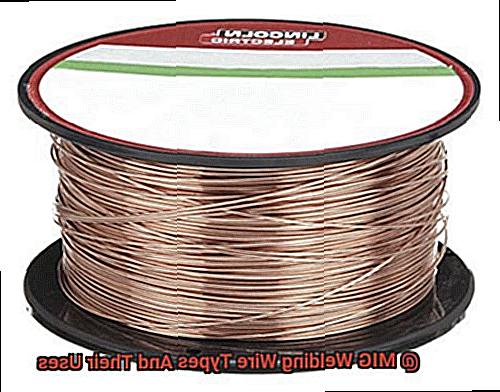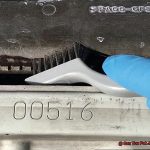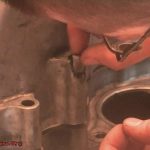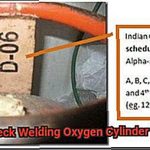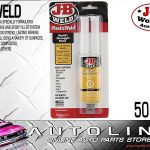Are you looking for the perfect welding wire to suit your project? With so many options available, it can be overwhelming to choose the right one. Luckily, MIG (Metal Inert Gas) welding wire is a top choice for professional welders due to its ease of use and high-quality results.
MIG welding wire comes in various types, each with unique properties that make them suitable for different applications. The most commonly used types are ER70S-3, ER70S-6, ER70S-7, and ER70S-G. ER70S-3 and ER70S-6 are ideal for welding mild and low-alloy steels.
In this blog post, we’ll dive into the different types of MIG welding wire and their uses. We’ll highlight the characteristics of each type to help you select the perfect one for your project. Additionally, we’ll discuss the benefits and drawbacks of each type so that you can make an informed decision.
Whether you’re a seasoned welder or just starting out, our guide will provide you with valuable insights into selecting the right type of welding wire for your application. From automotive to construction projects, we’ve got you covered.
So sit back, relax and let us take you on a journey through the world of MIG welding wire types and their uses. By the end of this post, you’ll have all the knowledge necessary to make an informed decision about which welding wire is best suited for your needs.
Types of MIG Welding Wire
Contents
- 1 Types of MIG Welding Wire
- 1.1 Solid Wire
- 1.2 Flux-Cored Wire
- 1.3 Aluminum Wire This superhero wire may be lightweight and corrosion-resistant, but it packs a powerful punch when it comes to welding aluminum and aluminum alloys. In MIG welding, there are two main types of aluminum wire: pure aluminum and aluminum alloy. Pure aluminum wire is perfect for welding pure aluminum, while aluminum alloy wire is used for welding alloys that contain other metals like copper, magnesium, or silicon. These metals can affect the strength and properties of the weld, so it’s crucial to choose the right type of wire for your specific project. But hold on a minute – there’s more to consider when selecting an aluminum wire for MIG welding. The thickness of the material being welded and the type of joint being created also play important roles. Thicker materials may require a larger diameter wire to ensure proper penetration and fusion, while thinner materials may need a smaller diameter wire to prevent burning through. It’s essential to note that not all MIG welding guns are created equal when it comes to using aluminum wire. Aluminum wire requires a specific type of gun and shielding gas that is designed for use with this type of wire. So before you start any welding project, make sure you have the correct equipment and knowledge. Using the correct type of aluminum wire for your MIG welding project is crucial for achieving a high-quality weld. Think of it like choosing the right tool for the job – you wouldn’t use a hammer to screw in a nail, would you? So consult with a professional or do thorough research before starting any welding project to ensure you’re using the right materials and techniques for your specific needs. Copper-Coated MIG Welding Wire
- 2 Factors to Consider When Choosing the Right MIG Welding Wire
- 3 Advantages of Using the Right Type of MIG Welding Wire
- 4 Disadvantages of Using the Wrong Type of MIG Welding Wire
- 5 Common Defects in MIG Welds and How to Avoid Them
- 6 Conclusion
Let’s dive into the world of MIG welding wire and explore the different types and their applications.
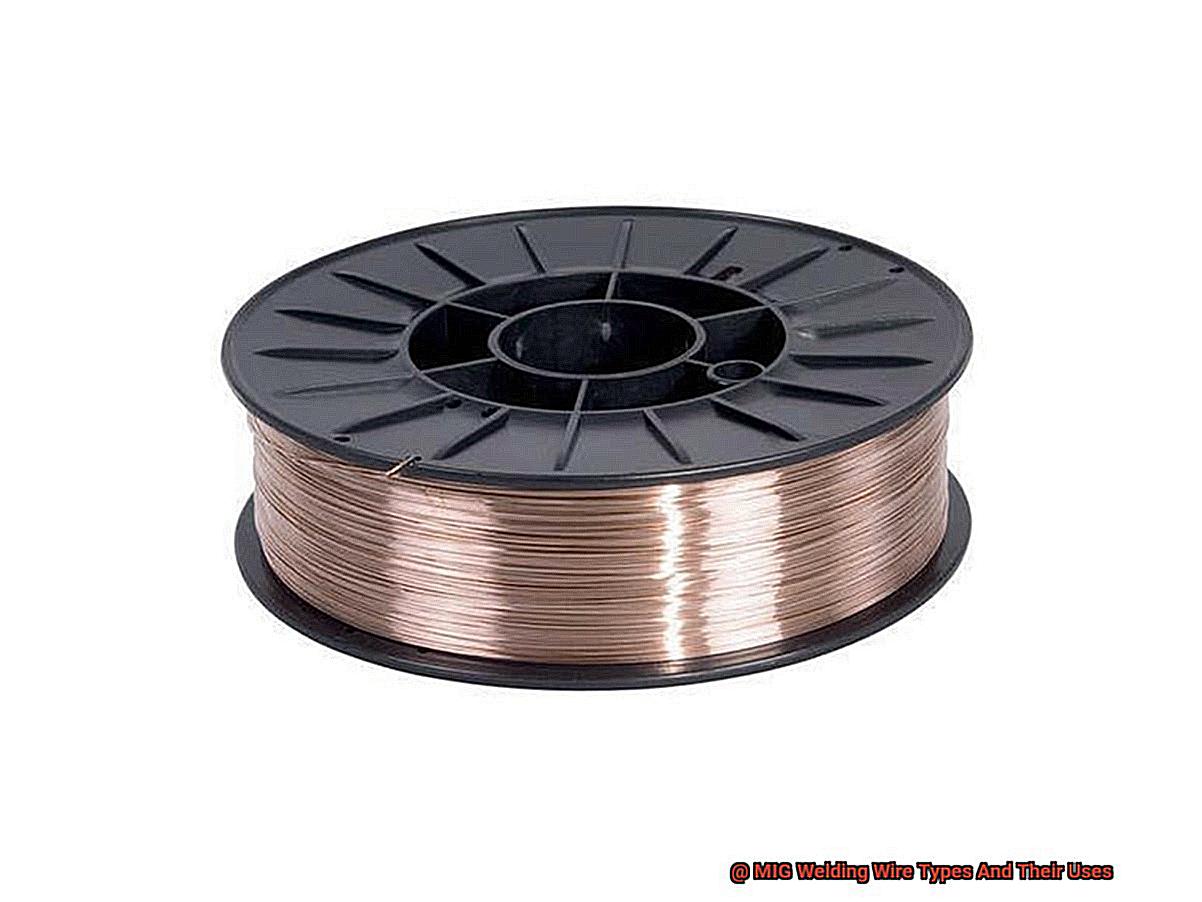
MIG welding is a widely used process that utilizes a consumable wire electrode to connect two base metals. The selection of wire is crucial in achieving high-quality welds with minimal defects. Let’s take a closer look at the various types of MIG welding wire available in the market today.
Solid Wire
Solid wire is a dependable and versatile option for MIG welding that can help you produce strong, clean welds quickly. This type of welding wire is made up of a solid metal wire that is fed through the MIG gun to create an electrical arc that melts the metal being welded. The best part? It’s available in a range of materials, including mild steel, stainless steel, and aluminum.
One of the most significant advantages of using solid wire in MIG welding is its ability to create clean welds with minimal spatter. This feature is particularly useful in applications where appearance is important or where cleaning up after welding would be difficult. Additionally, solid wire offers excellent penetration, making it easy to create strong welds quickly.
Mild steel solid wire is the most commonly used type of solid wire and is ideal for welding low-carbon steel. It’s often used in automotive repairs, construction projects, and general fabrication. On the other hand, stainless steel solid wire is perfect for welding stainless steel and is commonly used in the food and beverage industry, as well as for pharmaceutical and chemical applications.
Aluminum solid wire requires a higher voltage to create an arc due to its lower melting point. However, it’s versatile and can be used for various applications, including aerospace, automotive, and marine applications.
Flux-Cored Wire
Flux-cored wire is like the Robin to Batman in the world of MIG welding. While solid wire may get all the attention, flux-cored wire has its own set of superpowers that make it a great choice for certain welding applications.
One of the biggest advantages of flux-cored wire is its ability to weld thicker materials quickly, thanks to its higher deposition rates. The flux within its core also creates a protective gas shield that ensures the weld stays free from atmospheric contamination, resulting in a superior quality weld.
When it comes to choosing between self-shielded and gas-shielded flux-cored wire, the environment you’re working in plays a crucial role. If you’re welding outdoors, self-shielded wire is perfect since it creates its own protective shield and doesn’t require an external gas. Conversely, if you’re welding indoors, gas-shielded wire produces less spatter and offers better arc control, leading to a higher quality weld.
Keep in mind that selecting the right type of flux-cored wire depends on several factors. The thickness of the material being welded, as well as the welding position and desired welding speed, all factor into your decision.
Aluminum Wire
This superhero wire may be lightweight and corrosion-resistant, but it packs a powerful punch when it comes to welding aluminum and aluminum alloys.
In MIG welding, there are two main types of aluminum wire: pure aluminum and aluminum alloy. Pure aluminum wire is perfect for welding pure aluminum, while aluminum alloy wire is used for welding alloys that contain other metals like copper, magnesium, or silicon. These metals can affect the strength and properties of the weld, so it’s crucial to choose the right type of wire for your specific project.
But hold on a minute – there’s more to consider when selecting an aluminum wire for MIG welding. The thickness of the material being welded and the type of joint being created also play important roles. Thicker materials may require a larger diameter wire to ensure proper penetration and fusion, while thinner materials may need a smaller diameter wire to prevent burning through.
It’s essential to note that not all MIG welding guns are created equal when it comes to using aluminum wire. Aluminum wire requires a specific type of gun and shielding gas that is designed for use with this type of wire. So before you start any welding project, make sure you have the correct equipment and knowledge.
Using the correct type of aluminum wire for your MIG welding project is crucial for achieving a high-quality weld. Think of it like choosing the right tool for the job – you wouldn’t use a hammer to screw in a nail, would you? So consult with a professional or do thorough research before starting any welding project to ensure you’re using the right materials and techniques for your specific needs.
Copper-Coated MIG Welding Wire
This type of wire takes MIG welding, already known for its ease of use, to the next level.
The copper coating on the wire enhances electrical conductivity, resulting in a more stable arc and superior weld quality. It also provides protection against rust and corrosion, making it perfect for welding in humid or wet conditions.
But what makes copper-coated MIG welding wire truly remarkable is its versatility. It can weld mild steel, stainless steel, and even aluminum with ease, making it an ideal choice for those who need to weld different materials regularly.
And let’s not forget how user-friendly it is. Copper-coated MIG welding wire feeds smoothly through the gun and produces consistent results every time. Even novice welders or those with limited experience can use it without difficulty.
However, it’s essential to note that selecting the correct diameter for your specific application is crucial. The thickness of the wire affects the strength and penetration of the weld. Thicker wires are best for thicker materials, while thinner wires are ideal for thinner materials.
Factors to Consider When Choosing the Right MIG Welding Wire
When it comes to MIG welding, your choice of welding wire can make all the difference in the success of your project. Just like a painter selects the right brush for their canvas, you need to choose the right wire for your material. Here are five factors to consider when selecting the perfect welding wire.
Firstly, identify the material you will be welding. Whether it’s stainless steel or aluminum, choosing the right wire is crucial. Selecting the wrong wire is like using a hammer instead of a screwdriver – it just won’t work.
Next, consider the thickness of your materials. Thicker wires are suitable for thicker materials, while thinner wires are used for thinner materials. It’s like selecting the right needle for your thread – it needs to be a good match.
The type of shielding gas you’ll be using is also important to consider. Whether you’re using a CO2/argon mix or pure argon, there is a specific wire for each. Choosing the wrong wire is like pairing red wine with fish – it just doesn’t make sense.
The position in which you’ll be welding is another critical factor to consider. Just like an athlete needs to choose the right technique for each part of their routine, you need to select the right wire for each welding position. Certain wires are better suited for flat or horizontal positions, while others are ideal for vertical or overhead positions.
Lastly, think about your welding speed. Just like driving on a highway versus driving in a busy city, some wires are designed for high-speed welding, while others are better suited for slower speeds. Choosing the wrong wire for your speed is like wearing flip flops to run a marathon – it’s not going to work out well.
Advantages of Using the Right Type of MIG Welding Wire
Welding is an art form that requires precision and skill. Just like a painter needs the right brush to create a masterpiece, welders need the perfect MIG welding wire to achieve consistent and strong welds. So, what are the advantages of using the right type of MIG welding wire?
Firstly, improved weld quality is one of the main advantages of using the correct wire. Welders can achieve a consistent and strong weld that is resistant to cracking and porosity. This is because the wire’s composition and thickness ensure proper fusion and penetration of the material being welded. With the right wire, welds will be durable and stand the test of time.
Secondly, using the right type of MIG welding wire can increase productivity. Welders can work faster and more efficiently with less downtime due to wire feed problems or burnbacks. The correct wire also allows welders to make fewer passes, producing better results in less time. This means more work done in less time and more satisfied customers.
Finally, using the right type of MIG welding wire can save costs in the long run. While high-quality wires may have a higher upfront cost, they can reduce the need for rework or repairs due to poor weld quality. Additionally, using the correct wire minimizes waste by ensuring the right amount of filler metal is used for each weld. This means less wasted material and more money saved.
Disadvantages of Using the Wrong Type of MIG Welding Wire
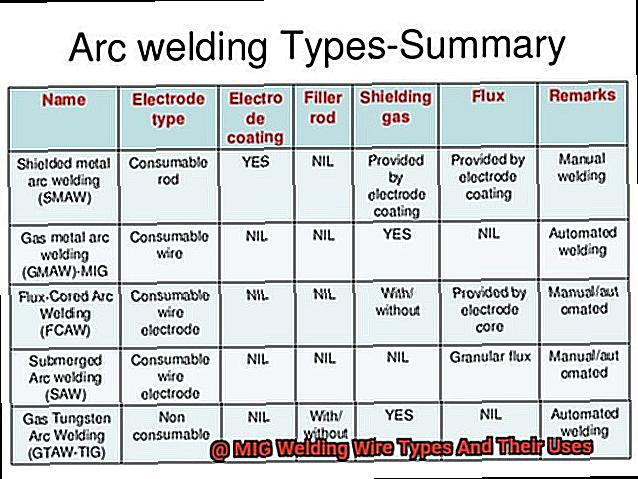
When it comes to MIG welding, the welding wire you choose is like the key to a lock – it can either open the door to a successful project or leave you fumbling with a broken key. Using the wrong type of MIG welding wire can lead to a variety of disadvantages that can affect both the quality of your weld and your safety.
One of the most significant disadvantages of using the wrong type of MIG welding wire is poor weld quality. Different welding wires are designed for specific materials and applications, and using the wrong wire for your project can result in weak welds that can break or fail under stress. Additionally, using the wrong wire can cause spatter, which is molten metal that splatters out of the weld and can damage surrounding areas or equipment. Imagine having to redo an entire project because of weak welds or damage caused by spatter – this can be both frustrating and expensive.
Increased costs are another disadvantage of using the wrong type of MIG welding wire. Using a wire that is not optimized for your specific application can lead to more frequent replacements and repairs, which can add up over time. Additionally, using the wrong wire can cause more rework and scrap, leading to even higher costs.
Using the wrong type of MIG welding wire can also pose safety risks. Welding produces fumes and gases that can be hazardous if inhaled, and some types of welding wires produce more fumes and gases than others. By using the wrong wire, you may be exposing yourself to more dangerous substances, which can have serious long-term health consequences. Additionally, if a weak weld fails while in use, it can pose a safety hazard to anyone nearby.
Common Defects in MIG Welds and How to Avoid Them
MIG welding may seem like a straightforward process, but it’s not without its challenges. One of the most significant obstacles is the potential for defects to arise during the welding process. Common defects like porosity, undercutting, burn-through, and warping can weaken your welds and lead to a lower quality finished product. However, with the right knowledge and attention to detail, you can avoid these pitfalls and create strong, high-quality MIG welds every time.
Porosity is one of the most common defects in MIG welding, and it can be a real headache. It occurs when gas pockets become trapped within the weld, causing it to weaken and become more susceptible to cracking or breaking. To avoid porosity, make sure you’re working in a clean and contaminant-free environment. Proper gas flow during the welding process is also critical to prevent gas pockets from forming.
Undercutting is another defect that can weaken your welds. This happens when the edges of the metal are melted away during the welding process, creating a groove or depression in the surface of the weld. To avoid undercutting, use proper welding techniques and maintain consistent heat levels during the welding process.
Burn-through is another frustrating defect that occurs when too much heat is applied to the metal during welding, melting it away completely and creating a hole in the metal. To avoid burn-through, use correct welding techniques and maintain proper heat levels throughout the process.
Lastly, warping is a common defect that can occur when the metal being welded becomes distorted or bent during the welding process. This leads to misaligned or uneven welds and ultimately weakens the finished product’s overall structure. To avoid warping, use clamps or other fixtures to hold your metal in place during welding and use a controlled heat source to prevent overheating.
GHEx6x-_zLo” >
Conclusion
In conclusion, understanding the different types of MIG welding wire and their uses is essential for achieving high-quality welds.
Whether you’re working with mild steel, stainless steel, or aluminum, there’s a specific type of wire that’s best suited for the job. By choosing the right wire and adjusting your welding technique accordingly, you can ensure that your welds are strong, durable, and visually appealing.
So take the time to learn about the various MIG welding wire types available and experiment with different options until you find the ones that work best for your particular needs.
You may also like:

